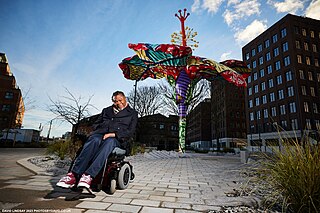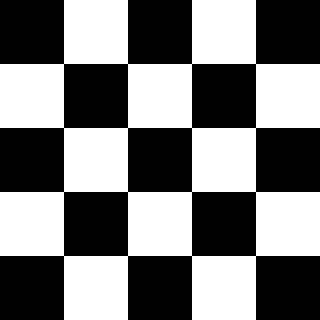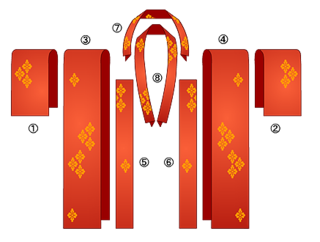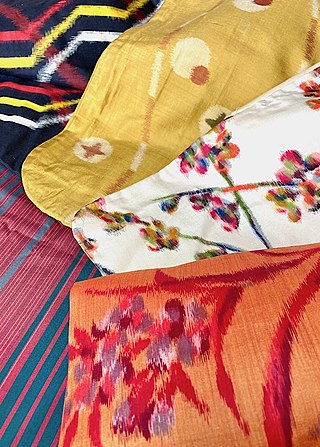Related Research Articles

Patchwork or "pieced work" is a form of needlework that involves sewing together pieces of fabric into a larger design. The larger design is usually based on repeating patterns built up with different fabric shapes. These shapes are carefully measured and cut, basic geometric shapes making them easy to piece together.

Weaving is a method of textile production in which two distinct sets of yarns or threads are interlaced at right angles to form a fabric or cloth. Other methods are knitting, crocheting, felting, and braiding or plaiting. The longitudinal threads are called the warp and the lateral threads are the weft, woof, or filling. The method in which these threads are interwoven affects the characteristics of the cloth. Cloth is usually woven on a loom, a device that holds the warp threads in place while filling threads are woven through them. A fabric band that meets this definition of cloth can also be made using other methods, including tablet weaving, back strap loom, or other techniques that can be done without looms.

A necktie, or simply a tie, is a piece of cloth worn for decorative purposes around the neck, resting under the shirt collar and knotted at the throat, and often draped down the chest.
Marimekko Oyj is a Finnish textiles, clothing, and home furnishings company founded by Viljo and Armi Ratia in Helsinki in 1951. Marimekko made important contributions to fashion in the 1960s. It is particularly noted for its brightly colored printed fabrics and simple styles, used both in women's garments and in home furnishings.

Yinka Shonibare, is a British artist living in the United Kingdom. His work explores cultural identity, colonialism and post-colonialism within the contemporary context of globalisation. A hallmark of his art is the brightly coloured Ankara fabric he uses. As Shonibare is paralysed on one side of his body, he uses assistants to make works under his direction.

Gingham, also called Vichy check, is a medium-weight balanced plain-woven fabric typically with tartan (plaid), striped, or check duotone patterns, in bright colour and in white made from dyed cotton or cotton-blend yarns. It is made of carded, medium or fine yarns.

Bògòlanfini or bogolan is a handmade Malian cotton fabric traditionally dyed with fermented mud. It has an important place in traditional Malian culture and has, more recently, become a symbol of Malian cultural identity. The cloth is exported worldwide for use in fashion, fine art and decoration.

A tabby cat, or simply tabby, is any domestic cat with a distinctive M-shaped marking on their forehead, stripes by their eyes and across their cheeks, along their back, around their legs and tail, and characteristic striped, dotted, lined, flecked, banded, or swirled patterns on the body: neck, shoulders, sides, flanks, chest, and abdomen. The four known distinct patterns, each having a sound genetic explanation, are the mackerel, classic or blotched, ticked, and spotted tabby patterns.

Michel Pastoureau is a French professor of medieval history and an expert in Western symbology.

Check is a pattern of modified stripes consisting of crossed horizontal and vertical lines which form squares. The pattern typically contains two colours where a single checker is surrounded on all four sides by a checker of a different colour.

Samite was a luxurious and heavy silk fabric worn in the Middle Ages, of a twill-type weave, often including gold or silver thread. The word was derived from Old French samit, from medieval Latin samitum, examitum deriving from the Byzantine Greek ἑξάμιτον hexamiton "six threads", usually interpreted as indicating the use of six yarns in the warp. Samite is still used in ecclesiastical robes, vestments, ornamental fabrics, and interior decoration.

Kalamkari is a type of hand-painted cotton textile produced in the Indian state of Andhra Pradesh. Only natural dyes are used in Kalamkari, which involves twenty-three steps.

Kijōka-bashōfu (喜如嘉の芭蕉布) is the Japanese craft of making cloth from the bashō or Japanese fibre banana as practiced in Kijōka in Ogimi, Okinawa. Like linen, hemp, ramie and other long vegetable fibres, it does not stick to the skin in hot weather; as such it is suitable for the climate of Okinawa. Kijōka-bashōfu is recognized as one of the Important Intangible Cultural Properties of Japan.

A stripe is a line or band that differs in color or tone from an adjacent area. Stripes are a group of such lines.

Sussi or susi is a term for multicolored striped or checked cloth produced mainly in Sindh. Sussi is thin handloom fabric made of cotton, silk, or a blend of the two, with colored warp stripes. Sindh region was known for its production and exports during the Mughal period. Sussi was most often made with red and blue, blue and white, or green and white stripes, but other patterns were also produced. The fabric was exported to England, where sousaes were in great demand in the 18th century.
Qutni(cuttanee, couthnys, Koetnies, Kutni) is an old silk and cotton mix cloth with a striped pattern. Qutni is a satin weave structure with silk in warp and cotton in the weft. It was made In Gujarat, India. Qutni was also produced at Damascus, Aleppo, Hama.
Alacha is a lightweight striped cloth made primarily of silk, sometimes cotton, or a mixture of both. The stripe pattern was evident on both sides of the fabric. A typical length of alacha is five yards. It was produced in various parts of India, for example Baikunthpur, Bihar. The cloth was popular in use for female garments such as dupattas (odhni), veils, and petticoats.

A tanmono is a bolt of traditional Japanese narrow-loomed cloth. It is used to make traditional Japanese clothes, textile room dividers, sails, and other traditional cloth items.
Dorea was a type of striped or check patterned cloth made in the Indian subcontinent. The continued striped Dorea was a simplest form of Dorea.

Meisen is a type of silk fabric traditionally produced in Japan; it is durable, hard-faced, and somewhat stiff, with a slight sheen, and slubbiness is deliberately emphasised. Meisen was first produced in the late 19th century, and became widely popular during the 1920s and 30s, when it was mass-produced and ready-to-wear kimono began to be sold in Japan. Meisen is commonly dyed using kasuri techniques, and features what were then overtly modern, non-traditional designs and colours. Meisen remained popular through to the 1950s.
References
- ↑ Sekules, DR Veronica (2003-01-01). "The Devil's Cloth: A History of Stripes and Striped Fabric by Michel Pastoureau". Textile. 1 (1): 110–112. doi:10.1080/17518350.2003.11428637. ISSN 1475-9756. S2CID 193598987.
- ↑ "The Devil's Cloth". Goodreads . Retrieved 2020-12-07.
- ↑ National Gallery of Art (U.S.) (2009). The Robert and Jane Meyerhoff collection : selected works. Internet Archive. Washington [D.C.] : National Gallery of Art. p. 27. ISBN 978-1-84822-050-8.
- ↑ Pastoureau, Michel (July 2001). "The Devil's Cloth: A History of Stripes and Striped Fabric". Columbia University Press.